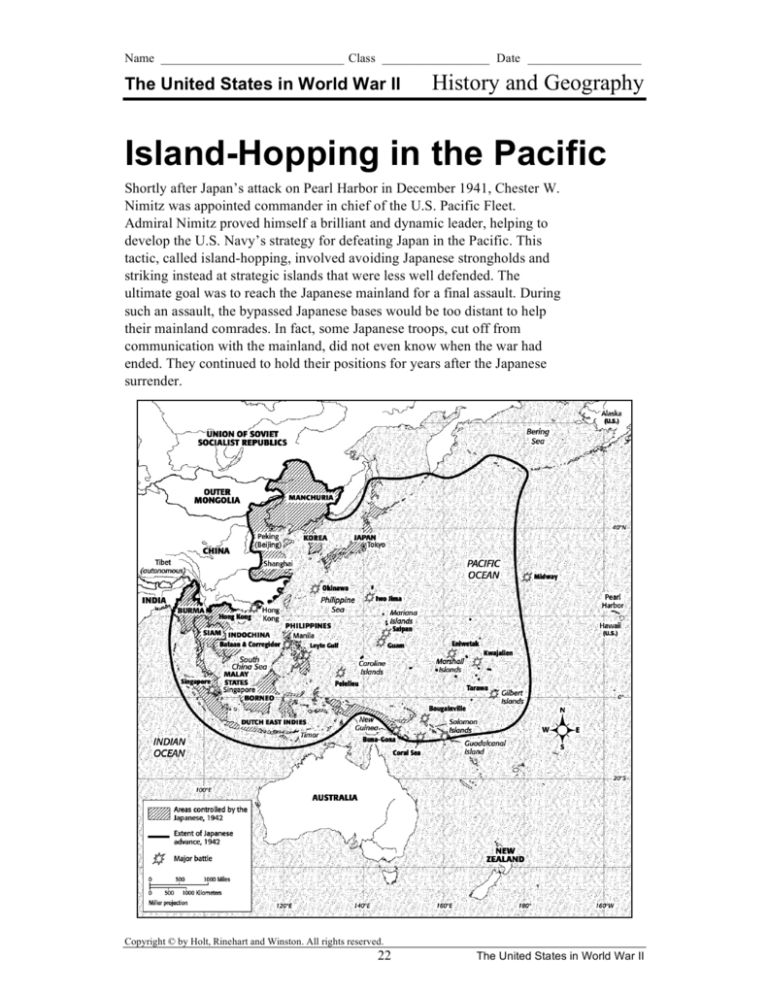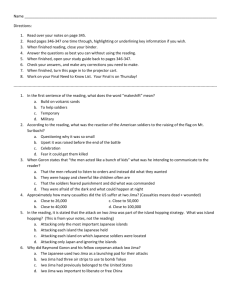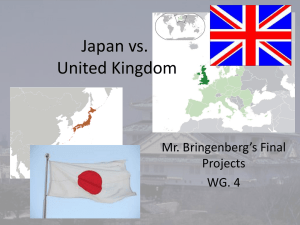
Name _____________________________ Class _________________ Date __________________
The United States in World War II
History and Geography
Island-Hopping in the Pacific
Shortly after Japan’s attack on Pearl Harbor in December 1941, Chester W.
Nimitz was appointed commander in chief of the U.S. Pacific Fleet.
Admiral Nimitz proved himself a brilliant and dynamic leader, helping to
develop the U.S. Navy’s strategy for defeating Japan in the Pacific. This
tactic, called island-hopping, involved avoiding Japanese strongholds and
striking instead at strategic islands that were less well defended. The
ultimate goal was to reach the Japanese mainland for a final assault. During
such an assault, the bypassed Japanese bases would be too distant to help
their mainland comrades. In fact, some Japanese troops, cut off from
communication with the mainland, did not even know when the war had
ended. They continued to hold their positions for years after the Japanese
surrender.
Copyright © by Holt, Rinehart and Winston. All rights reserved.
22
The United States in World War II
Name _____________________________ Class _________________ Date __________________
The United States in World War II
History and Geography
MAP ACTIVITY
1. In September 1940, Japan signed a pact with the other Axis powers, Germany and
Italy. On the map, highlight the islands of Japan.
2. The United States had two allies in the Pacific: Australia and New Zealand. Use a
different color to highlight Australia and New Zealand.
3. On December 7, 1941, Japan attacked Pearl Harbor, leading Congress to declare war
on Japan. Find Pearl Harbor on the map and circle it.
4. Between November 1943 and April 1945, Admiral Nimitz targeted the following
islands and island chains in the Pacific in consecutive order: the Gilbert Islands,
Marshall Islands, Mariana Islands, Iwo Jima, and Okinawa. On the map, draw arrows
from one island to the next, illustrating the sequence of Allied offensives.
ANALYZING MAPS
1. Movement According to the map’s scale, approximately how many miles did
Admiral Nimitz “island-hop” from the Mariana Islands to Iwo Jima?
____________________________________________________________________
2. Movement In what general direction did the U.S. Navy’s island-hopping progress?
____________________________________________________________________
3. Location Looking at the map, why do you think control of Iwo Jima was
strategically important for the Allies?
____________________________________________________________________
____________________________________________________________________
4. Analyze Admiral Nimitz’s strategy was to target selected Japanese fortresses in the
Pacific on a drive toward a final attack on Japan. How successful was the U.S. Navy
in this campaign?
____________________________________________________________________
____________________________________________________________________
EXTENSION ACTIVITY
As the U.S. Navy captured Okinawa, President Truman was contemplating
the use of atomic weapons to force Japan’s surrender. Truman believed this
approach would prevent heavy American casualties that might result from
an invasion of Japan. Admiral Nimitz, on the other hand, considered the
atomic bomb to be a cruel and unacceptable form of warfare. Nimitz
favored provoking surrender by fierce combat, using ships and submarines.
Research these two viewpoints and debate them with classmates.
Copyright © by Holt, Rinehart and Winston. All rights reserved.
23
The United States in World War II
Answer Key
The United States in World War II
Islands, from the Mariana Islands to Iwo
Jima, and from Iwo Jima to Okinawa.
Primary Source
Presidential Address on the
Declaration of War on Japan
ANALYZING MAPS
1. Movement approximately 600 miles
(965 km)
2. Movement northwest
3. Location Located about 760 miles
southeast of Tokyo, Iwo Jima was
geographically and strategically important
to the Allies as they moved toward Tokyo.
From Iwo Jima, Nimitz was able to
coordinate and carry out effective bombing
of the cities and industrial centers of the
Japan’s main islands.
4. Analyze The U.S. Navy was very
successful in its island-hopping campaign.
As planned, each captured island brought
the Allies closer to the Japanese mainland,
until Japan was within 500 miles of the
Allied forces on Okinawa.
WHAT DID YOU LEARN?
1. the Axis powers
2. The attack on Pearl Harbor was part
of a pattern of Axis powers repeatedly
attacking nations around the world
without warning.
3. He wanted to make clear that for true
victory, it was necessary for the United
States and the Allies to defeat not only
Japan, but also Germany and Italy.
Memorandum Regarding the
Enlistment of Navajo Indians
WHAT DID YOU LEARN?
1. A Marine could give a message in English
to a code talker, who would then use a
radio to transmit the message in Navajo to
another code talker. The second Navajo
would then translate the message back to
English for a Marine at his location.
2. He knew that Navajo was the only Native
American dialect that students from
Germany had not studied and that Navajo
was unintelligible to people who were not
familiar with the language.
3. The Navajo did not have words in their
language for many military terms; they had
a low literacy rate; and code talkers needed
to be proficient in both English and
Navaho.
EXTENSION ACTIVITY
Students should research President Truman’s
and Admiral Nimitz’s opposing viewpoints on
using the atomic bomb to end World War II
and debate the opposing arguments in class.
Economics and History
Mobilization Ends the
Depression
WHAT DID YOU LEARN?
1. 1933; 1944.
2. The Great Depression coincided with the
period of highest unemployment. World
War II coincided with the period of lowest
unemployment.
3. 12,848,400 people
4. 1,054,500 people
5. Student answers may vary but should
suggest that the Great Depression was
associated with a period of economic
slowdown, and World War II caused a
significant economic boom.
History and Geography
Island-Hopping in the Pacific
MAP ACTIVITY
1. Students should highlight the islands
of Japan.
2. Students should highlight the islands of
Australia and New Zealand.
3. Students should circle Pearl Harbor.
4. Students should draw arrows from the
Gilbert Islands to the Marshall Islands,
from the Marshall Islands to the Mariana
Copyright © by Holt, Rinehart and Winston. All rights reserved.
37
The United States in World War II









